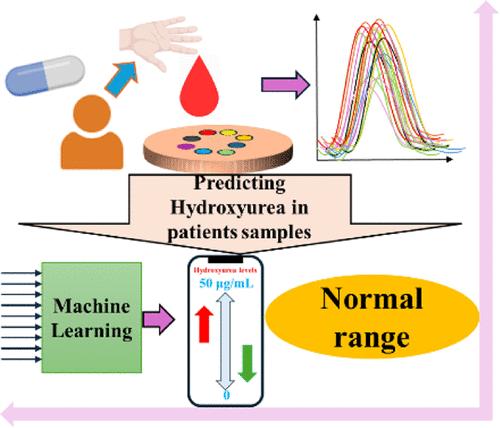Microsensor Array for the Electrochemical Analysis of Hydroxyurea in Blood Samples of Children Affected by Sickle Cell Anemia
IF 6.7
1区 化学
Q1 CHEMISTRY, ANALYTICAL
引用次数: 0
Abstract
Sickle cell anemia (SCA) is an inherited blood disorder that causes morbidity and early mortality. Hydroxyurea is an effective oral medication to treat SCA, and optimal dosing benefits from pharmacokinetic (PK)-based methods that require accurate analysis of hydroxyurea levels in timed patient blood samples. Current gold standard assay methods, such as liquid chromatography–mass spectrometry (LC-MS), require sophisticated instrumentation, trained personnel, and laborious sample pretreatment steps that may alter target molecule levels. Additionally, LC-MS is time-consuming and costly, leading to delays in treatment decisions and making it infeasible for use in low-resource settings. Herein, we report a novel approach for the chemical analysis of serum hydroxyurea levels by using an array of electrochemical microsensors modified with thin films of nanomaterials to record the electrochemical signature of blood samples from 50 children treated with hydroxyurea. To analyze this complex data set, multiple machine learning models were trained and optimized to predict hydroxyurea levels from microliter sample volumes. We evaluated three regression algorithms: elastic net, random forest (RF), and partial least-squares regression (PLSR) across 11 different electrochemical feature matrices. Among these, PLSR demonstrated the best performance, achieving a root-mean-square error of 41.85 μM (3.18 μg/mL) and an average prediction error of 7.24 μM (0.55 μg/mL), thereby enabling accurate analysis of hydroxyurea levels within the therapeutic range using microliter sample volumes from pediatric patients. With further miniaturization of such sensor arrays and integration into point-of-care testing devices, hydroxyurea PK-based dosing can be simplified for use in low-resource settings to improve SCA treatment outcomes worldwide.

微传感器阵列用于镰状细胞性贫血患儿血液中羟基脲的电化学分析
镰状细胞性贫血(SCA)是一种遗传性血液疾病,可导致发病和早期死亡。羟基脲是治疗SCA的有效口服药物,基于药代动力学(PK)的方法需要准确分析患者血液样本中的羟基脲水平,从而获得最佳剂量。目前的金标准分析方法,如液相色谱-质谱(LC-MS),需要复杂的仪器,训练有素的人员,和费力的样品预处理步骤,可能会改变目标分子水平。此外,LC-MS耗时且昂贵,导致治疗决策延迟,在资源匮乏的环境中不可行。在此,我们报告了一种新的方法,用于血清羟脲水平的化学分析,通过使用纳米材料薄膜修饰的电化学微传感器阵列来记录50名接受羟脲治疗的儿童血液样本的电化学特征。为了分析这一复杂的数据集,对多个机器学习模型进行了训练和优化,以预测微升样品体积中的羟基脲水平。我们在11种不同的电化学特征矩阵中评估了三种回归算法:弹性网络、随机森林(RF)和偏最小二乘回归(PLSR)。其中,PLSR表现最佳,均方根误差为41.85 μM (3.18 μg/mL),平均预测误差为7.24 μM (0.55 μg/mL),可以在治疗范围内使用微升儿科患者的样品体积准确分析羟基脲水平。随着这种传感器阵列的进一步小型化和集成到护理点测试设备中,羟基脲磷酸基给药可以简化,用于低资源环境,以改善全球SCA治疗结果。
本文章由计算机程序翻译,如有差异,请以英文原文为准。
求助全文
约1分钟内获得全文
求助全文
来源期刊

Analytical Chemistry
化学-分析化学
CiteScore
12.10
自引率
12.20%
发文量
1949
审稿时长
1.4 months
期刊介绍:
Analytical Chemistry, a peer-reviewed research journal, focuses on disseminating new and original knowledge across all branches of analytical chemistry. Fundamental articles may explore general principles of chemical measurement science and need not directly address existing or potential analytical methodology. They can be entirely theoretical or report experimental results. Contributions may cover various phases of analytical operations, including sampling, bioanalysis, electrochemistry, mass spectrometry, microscale and nanoscale systems, environmental analysis, separations, spectroscopy, chemical reactions and selectivity, instrumentation, imaging, surface analysis, and data processing. Papers discussing known analytical methods should present a significant, original application of the method, a notable improvement, or results on an important analyte.
 求助内容:
求助内容: 应助结果提醒方式:
应助结果提醒方式:


